Operating review
Technical investments
Technical investments totalling 882 million euro (1,034 million euro in 2017) referred mainly to the natural gas transportation (764 million euro) and storage (99 million euro) business segments.
Infrastructure development and integration
The main investments for the development of new infrastructure mainly involved work for the reversal of physical transportation flows at interconnection points with northern Europe (150 million euro), the upgrade of the transportation network from entry points in southern Italy (8 million euro) and the upgrade of the network and connection of new regional and national redelivery points (106 million euro). A total of 26 million euro was invested in 2018 for the development of new storage fields and upgrading capacity.
Considering the works completed and decommissioning that took place during the year, the network of operating gas pipelines increased by 41 km on 31 December 2017, whilst installed power in compression plants came to 961 megawatts, up 59 megawatts thanks to the commissioning of the new Minerbio and Sergnano plants. Available storage capacity rose by 0.2 billion cubic metres, made available by the new Bordolano deposit, to a level of 12.4 billion cubic metres.
Maintenance of plant security and quality
Investments in projects aimed at maintaining plant security and quality totalled 366 million euro for transmission and 57 million euro for storage.
Throughout the year, the plants in the network are monitored 24 hours a day. With the help of simulation and optimisation programmes, their best asset is guaranteed with the aim of reducing the consumption of gas boosting fuels and thus containing the level of emissions.
The section of lines is inspected regularly by vehicles, using helicopters and personnel on foot in order to detect potentially hazardous situations caused, for example, by the works of third parties in the area of the pipelines. Geological inspections of the pipeline section are also carried out to identify potential instabilities along the sections. Similarly, any land slippage at specific points along the route is also kept under surveillance, using appropriate sophisticated equipment, if needed. Pipeline integrity is also monitored by passing a smart pig inside them to detect of any material defects or anomalies.
| Download XLS (17 kB) |
(km) |
2016 |
2017 |
2018 |
Network inspected using smart pigs |
1,660 |
1,632 |
1,651 |
Network inspected by helicopter |
16,218 |
16,274 |
18,462 |
Network subjected to geological inspection |
1,478 |
4,080 |
4,209 |
In terms of storage, particular attention is paid to the safety plants and people. Regular maintenance and plant improvement interventions are performed on a continuous and targeted basis, in order to always apply the best available technologies. In addition to the drills required by the Seveso Directive, in 2018, at the Panigaglia regasification terminals, Snam conducted monthly safety drills simulating accidental leaks of LNG. A joint Security and Safety exercise was also carried out with the Port Authority, the Fire Department, the police, and the emergency medical services.
72.82
Bn m3 gas injected into the
network (-2.4%)
The average transportation capacity provided in 2018 was 360.8 million cubic metres/day on average, which was in line with 2017 (-0.9%), while transferred capacity totalled 287.0 million cubic metres/day on average. Network saturation5 was 79.5%, a rise compared with 2017 (71.0%).
The number of active transport users in 2018 was 136, compared to 128 users active in 2017. During the year, 88 connection agreements were entered into for the creation of new delivery/redelivery points, including 14 biomethane points and 43 CNG.
72.66
Bn m3 gas demand (-3.3%)
Overall storage capacity, including strategic storage, was 16.9 billion cubic metres at 31 December 2018, an increase of 0.2 billion cubic metres over 2017, following the Bordolano site’s gradual entry into service, of which 12.4 was available capacity that was fully transferred for the 2018-2019 thermal year (99.7%), and the remaining 4.5 billion cubic metres was for strategic storage.
There were 91 active storage customers (89 in 2017).
Business volume
+5.8%
volumes moved
In 2018, a total of 72.82 billion cubic metres of gas was injected into the network, a reduction of 1.77 billion cubic metres (-2.4%) compared with 2017. The reduction can mainly be attributed to the lower consumption recorded in the thermoelectric business segment (-2.08 billion cubic metres; -8.2%) following the return to the normal flows of electricity imports, which reduced in 2017 due to the downtime of some French nuclear plants in the first two months of the year and the increase in hydroelectric production, which has returned to normal levels after the water shortage that characterised 2017.
+44.4%
m3 regasified
Volumes of gas moved through the storage system in FY 2018 amounted to 21.07 billion cubic metres, an increase of 1.15 billion cubic metres, or 5.8%, compared with FY 2017.
The increase can be attributed to both greater injections for filling storage (+0.84 billion cubic metres; + 8.6%) and to greater deliveries from storage (+0.31 billion cubic metres; +3.1%), mainly following the climatic conditions in the first few months of 2018.
During 2018, 0.91 billion cubic metres of LNG were regasified at the Panigaglia (SP) LNG terminal (0.63 billion cubic metres in 2017; +0.28 billion cubic metres, or 44.4%). In 2018, 21 methane tanker loads were unloaded (15 in 2017; +40%).
Key operating figures
In conformity with IFRS 8 “Operating segments”, the operating segments were defined on the basis of the internal reporting used by the Company’s management for allocating resources to the different segments and for analysing the respective performances. To this end, please note that the companies that joined the consolidation scope in FY 2018 have been consolidated within the Corporate and other businesses segment.
| Download XLS (20 kB) |
|
2016 |
2017 |
2018 |
Change |
% change |
||||||||||
|
|||||||||||||||
Natural gas transportation (a) |
|
|
|
|
|
||||||||||
Natural gas injected into the National Gas Transportation Network (billions of cubic metres) (b) |
70.64 |
74.59 |
72.82 |
(1.77) |
(2.4) |
||||||||||
Transportation network (km in use) |
32,508 |
32,584 |
32,625 |
41 |
0.1 |
||||||||||
Installed power in the compression stations (MW) |
922 |
902 |
961 |
59 |
6.5 |
||||||||||
Liquefied natural gas (LNG) regasification (a) |
|
|
|
|
|
||||||||||
LNG regasification (billions of cubic metres) |
0.21 |
0.63 |
0.91 |
0.28 |
44.4 |
||||||||||
Natural gas storage (a) |
|
|
|
|
|
||||||||||
Available storage capacity (billions of cubic metres) (c) |
12.0 |
12.2 |
12.4 |
0.2 |
1.6 |
||||||||||
Natural gas moved through the storage system (billions of cubic metres) |
20.00 |
19.92 |
21.07 |
1.15 |
5.8 |
||||||||||
Employees in service at period end (number) (d) |
2,883 |
2,919 |
3,016 |
97 |
3.3 |
||||||||||
of which business segments: |
|
|
|
|
|
||||||||||
- Transportation |
1,726 |
1,972 |
1,915 |
(57) |
(2.9) |
||||||||||
- Regasification |
71 |
63 |
64 |
1 |
1.6 |
||||||||||
- Storage |
301 |
60 |
59 |
(1) |
(1.7) |
||||||||||
- Corporate and other activities (e) |
785 |
824 |
978 |
154 |
18.7 |
||||||||||
Personel trend
The number of employees in service as at 31 December 2018 was 3,016 (n. 2,919 employees as at 31 December 2017), an increase of 97 (+3.3%) over the previous year. The average number of payroll employees for entities included in the scope of consolidation as at 31 December 2017 was 2,949 (2,860 employees in 2017).
During the year, 2018 recorded the following performance:
- 321 new resources, of whom 195 hired from the market, 126 other new employees, including 61 resources due to a change in the consolidation of the company Cubogas S.r.l. as from 25 July 2018, 22 resources for the acquisition of TEP Energy Solution from June 2018, 34 resources for the acquisition of IES Biogas in July 2018, 9 returns to service from leave;
- 189 employees left the company, including 49 as a result of the termination of employment, 41 were terminated unilaterally (comprising both dismissals and redundancies) and 99 departures under Isopensione. Another 10 employees left on leave and 25 were transferred to companies that are not consolidated.
With respect to the Group’s national distribution, 2,302 people are employed in the northern regions of Italy, 220 in the central regions and 490 in the south. Furthermore, 4 individuals are permanently employed abroad.
Industrial relations
In 2018, the relationship with the trade union organisations at a national and local levels was characterised by numerous meetings (109) regarding plans for business evolution and new organisational structures, also following the acquisition of Cubogas.
As regards to transmission and storage, the integration deriving from the “Integra” project continued, which calls for integrating side activities of the operational companies to develop and exploit the specific skills.
For the transportation business, the Smart Gas technical committee’s work continued, seeking for a more rational scheduling of the operations with the objective of analysing the technical aspects of the project. Moreover, a technical commission has been set up for the “Smart Gas Plants” project, with the aim of analysing the technical matters relating to this further technical organisational evolution.
In the regasification area, meetings were held with the trade unions, at national and local level, aimed at sharing and comparing the issues concerning the evolution of the business.
The bargaining dynamics, consistent with the provisions of the 2013 Industrial Relations Protocol, whose reasoning were imbued with the concept of strengthening second-level negotiations, led the Parties to define productivity and profitability indicators for the 2018 Participation Bonus for all Snam group companies.
Furthermore, all the Snam group companies signed the implementation agreement pursuant to the Article 4 of the Italian Law 92/2012 for an early exit of a further 110 workers who meet the requirements prescribed by the law.
By trade union agreement, the electronic ticket has been introduced group-wide in all territorial operative contexts.
Supply chain management
Snam adopts an ‘extended’ management model that, going beyond the boundaries of its company perimeter, involves and takes on the responsibility of supply chain operators (suppliers and subcontractors): everyone is encouraged to achieve increasingly sustainable performance in terms of risk mitigation, innovation of management processes, increase in operational efficiency and promotion of responsible governance procedures.
In 2018, Snam directly provided work for around 540 companies, 399 of which belong to the small-medium business sector (SME), concluding 753 procurement contracts worth a total of approximately 1.5 billion euro. Among the goods purchased the most important material is steel (piping, connectors, etc.) which, in 2018, amounted to a supply of approximately 46,400 tonnes.
The increase in procurement on 2017 (approximately + 80%) was determined by the multi-year planning of purchases, the cyclical nature of the procurement process by virtue of the stipulation of contracts signed during previous years and new business activities.
More than 92% of the procurement concerns Italy (distributed in all Italian regions in line with the territorial belonging of each company), and about 8% concerns Europe. As regards business abroad, in 2018 Snam stipulated approximately 20 contracts for new activities (for a value of 6.5 million euro), thereby strongly boosting its globalisation. By virtue of its consolidated know-how in the management of complex orders, Snam operated for the first time in the United Kingdom as EPC contractor, simultaneously managing the procurement of materials, engineering and construction of plants (gas turbines). Activities will continue into 2019, further bearing out Snam’s role as industry leader in Europe. During the year, important activities were also launched ahead of the imminent entrance of the Chinese market, scheduled for 2019.
In order to guarantee the adequacy of the suppliers with respect to procurement needs, Snam constantly carries out market intelligence and scouts out new suppliers: in 2018, more than 500 businesses were contacted in relation to around sixty different product categories, and approximately 200 new candidates started qualification proceedings. The number of spontaneous applications received from prospective suppliers amounted to circa 1,300.
As at 31 December 2018, the vendor list included 1,465 qualified suppliers, and 611 suppliers were in the process of being renewed or obtaining new qualifications. Snam exercises control of its supply chain by monitoring supplier performance during the execution phase of contracts through audits, inspections and evaluation processes. During the year, 815 feedback reports were collected on the services rendered by 157 suppliers. Additionally, 1,831 suppliers and sub-contractors were checked with regard to the regularity of contributions, through 3,980 inspections which led to the interception of 2.2% of irregularities.
With regard to the fight against corruption, all suppliers and subcontractors are required to accept the Integrity Ethics Pact and are subject to reputational checks. A total of 2,074 reputational checks were performed in 2018.
In the procurement of works, which is the most important category because it is related to core activities, the suppliers considered critical (critical levels A and B) were all in possession of quality and environment management systems certified with ISO 9001, ISO 14001 and ISO 18001 standards. The objective to have at least 65% of the suppliers of goods (critical level A) who possess environmental management systems certified according to ISO 14001, set in 2017, was achieved in 2018.
Figures for the 2018 procurement procedure do not include the newly acquired companies TEP, IES Biogas and Cubogas.
| Download XLS (16 kB) |
(€ million) |
2016 |
2017 |
2018 |
2016-2018 |
Amount of purchases |
1,359 |
844 |
1,520 |
3,723 |
Geographic breakdown of procurement in Italy (%) (*)
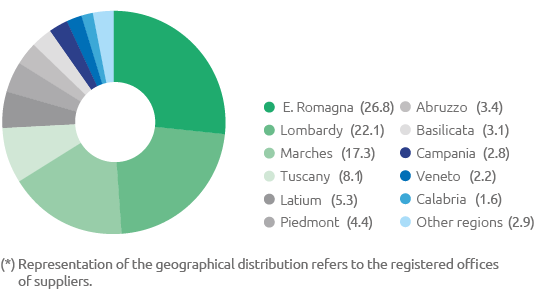
Procurement by goods type
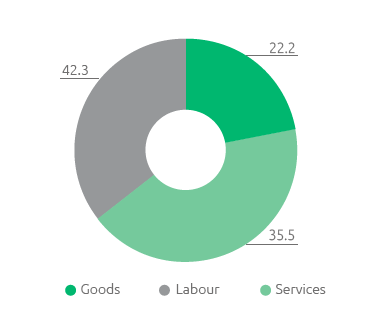
Procurement by business segment
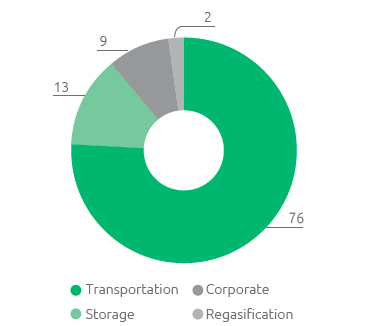
Accidents
Snam is constantly committed to developing and promoting health and safety in the workplace. Research into and the adoption of good business practices is subject to a gradual promotion not only within the company, but also vis-à-vis the suppliers, to extend and improve collaboration to achieve the best performance.
In 2018, there were a total of 7 accidents (11 in 2017), of which 4 occurred to employees (6 in 2017) and 3 to contracting suppliers (5 in 2017); no accidents had a fatal outcome.
| Download XLS (16 kB) |
(no.) |
2016 |
2017 |
2018 |
Total employee accidents |
4 |
6 |
4 |
Total contract worker accidents |
5 |
5 |
3 |
| Download XLS (17 kB) |
|
2016 |
2017 |
2018 |
||||
|
|||||||
Employees and contract workers |
|
|
|
||||
Frequency index |
0.75 |
0.78 |
0.58 |
||||
Severity index |
0.05 |
0.56 |
0.02 |
||||
Employees |
|
|
|
||||
Frequency index |
0.81 |
1.24 |
0.84 |
||||
Severity index |
0.04 |
0.05 |
0.02 |
||||
Contract workers |
|
|
|
||||
Frequency index |
0.71 |
0.54 |
0.41 |
||||
Severity index |
0.05 |
0.83 |
0.03 |
||||
Accidents at work - Employee and contract worker frequency index (*)
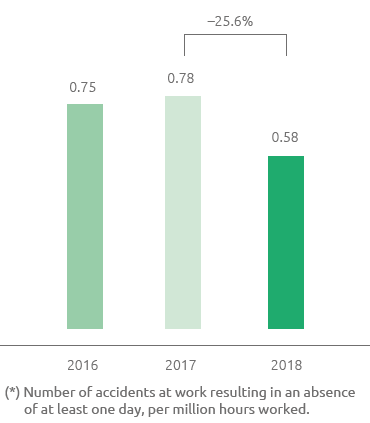
Accidents at work - Employee and contract worker severity index (*)

Energy consumption
Most of Snam’s energy consumption is attributed to gas turbines used in compression systems that provide the pressure required for gas transportation (thrust consumption) and in storage concessions (storage consumption) that, overall, represent 88% of total consumption.
In 2018, energy consumption totalled around 13,281 TJ (+5.6% compared with 2017). This increase is mainly due to greater natural gas consumptions brought about by the increase in the quantity of gas stored in deposits (+9%) and the commissioning of new compression plants (Minerbio and Sergnano), which have required significant fuel consumptions to commission the plants.
In addition to natural gas, the other energy sources are electricity (2.8%) and other fuels (diesel fuel, gasoline, LPG and heat), which together amount to 0.8% of the total consumption.
Energy consumption (TJ)
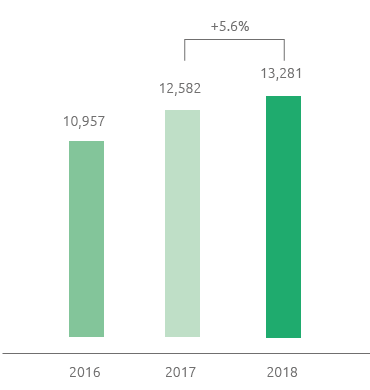
Energy consumption by business segment (%)
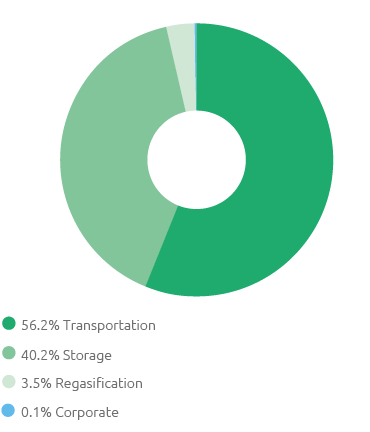
Greenhouse gas emissions
In 2018, the direct CO2eq emissions amounted to approximately 1.5 million tonnes (stable on 2017). CO2 emissions from combustion amounted to approx. 0.727 million tonnes (+5.2% compared with 2017), whereas the CO2eq emissions deriving from the methane emissions amounted to approximately 0.77 million tonnes (-4.8% compared with 2017). Natural gas emissions came in at 44.4 million of m3, down on the 46.8 million of m3 booked for 2017. The increase in CO2 emissions from combustion is mainly due to the greater natural gas consumptions brought about by the increase in the quantity of gas stored in deposits (+9%) and the increase in plants (two new compression plants), which have required significant fuel consumptions to commission the plants.
The company has set targets for the reduction of its natural gas emissions by 2022 and 2025 respectively as 15 and 25%, net of emergencies, with respect to 2016 values. In 2018, the emission into the atmosphere was avoided of 8.2 million cubic metres of natural gas, equal to approximately 142,200 tonnes of CO2eq (+ 99% on the 71,500 tonnes of CO2eq in 2017). This performance was made possible thanks to gas recompression interventions in the line (13 interventions carried out as compared with the 8 in 2017) and interventions with tapping machines, a technology that can detach methane pipelines operating for new connections without interrupting service. These results led to a reduction in 2018 emissions of 7.9% on 2016, a trend that is entirely in line with the general objective.
In 2018, the Snam Group’s total CO2 emissions from ETS plants, certified by an accredited body according to the provisions of the competent national authority, amounted to approximately 0.67 million tonnes, out of total annual allowances of approximately 0.20 million issued by the Ministry for the Environment, Land and Sea (negative balance of 0.47 million allowances). This deficit is partly offset by the quotas already present in the Snam Rete Gas plant registers, accumulated thanks to the surplus of previous years, and with the further purchase of approximately 0.20 million tonnes on the European quotas market.
With consultation document 512/2018/R/gas, published on 18 October 2018 and relating to the criteria applied to determine the revenues recognised for the fifth regulatory period for the transmission of natural gas (2020-2023), the Regulatory authority (ARERA) proposed introducing a variable price applied to the values transported, also intended to cover the costs relating to the Emission Trading system.
| Download XLS (17 kB) |
Activity |
No. of plants |
Name of plants |
Transportation |
13 |
Gas compression stations in Enna, Gallese, Istrana, Malborghetto, Masera, Melizzano, Messina, Montesano, Poggio Renatico, Tarsia, Terranuova Bracciolini, Minerbio, Sergnano |
Storage |
8 |
Storage gas compression stations in Cortemaggiore, Fiume Treste, Minerbio, Ripalta, Sabbioncello, Sergnano, Settala and Bordolano |
Regasification |
1 |
Liquefied natural gas plant in Panigaglia |
Total direct GHG emissions - Scope 1 (kt CO2eq) (*)
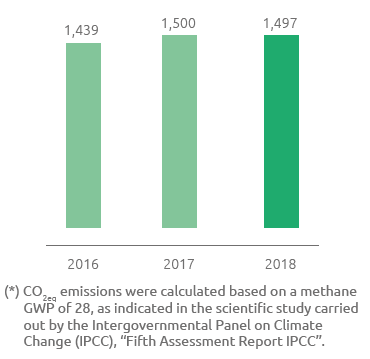
CO2 emissions from ETS plants (106 t)
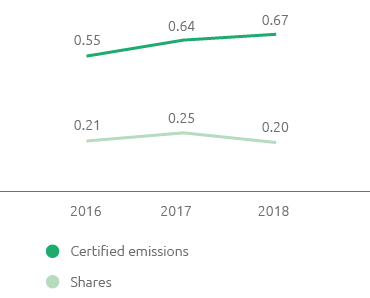
5 Ratio of capacity transferred to available capacity.